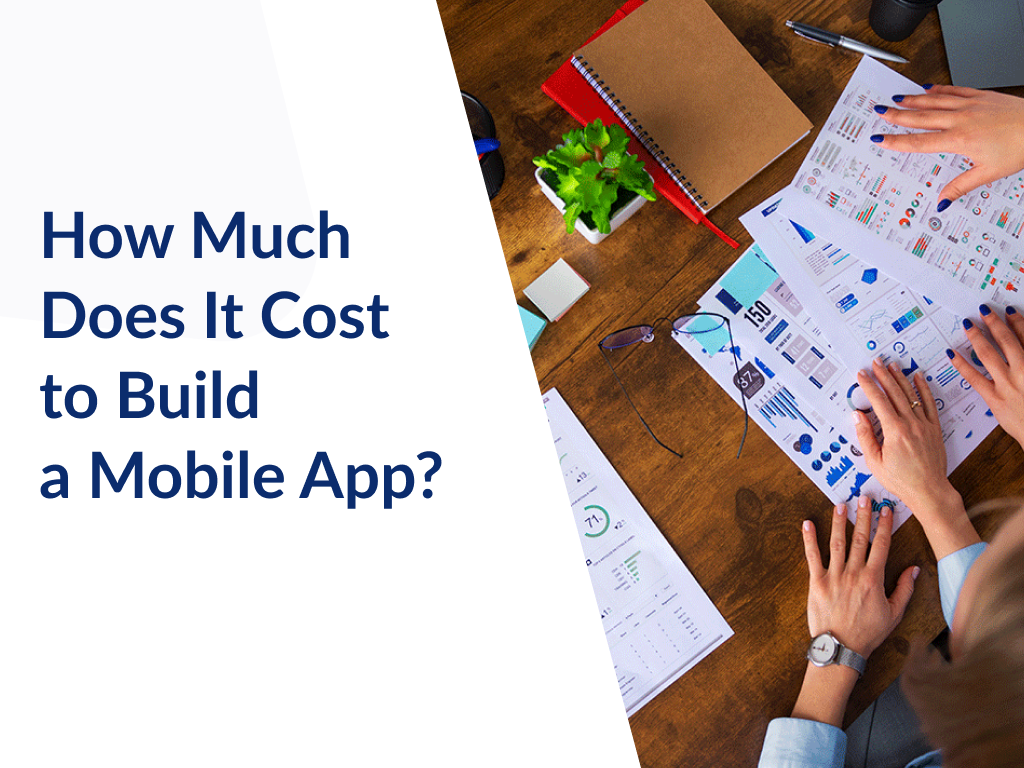
As per Statista, the number of mobile app downloads worldwide has been increasing constantly from 2016 onward, surpassing 200 billion in 2019. In the most recently measured year, consumers downloaded 255 billion mobile apps to their connected devices, up by more than 80 percent from 140.7 billion app downloads in 2016.
So if you are an aspiring entrepreneur in the European market with a groundbreaking app idea, wondering about the cost of turning your vision into reality? You’ve come to the right place!
In this article, we’ll delve into the world of mobile app development and uncover the factors that influence the cost of building a mobile app. We’ll also explore how to find the perfect mobile app development company to bring your app to life.
Understanding How Mobile Apps Are Built
Mobile app development is a multifaceted process that transforms ideas into functional applications for mobile devices. It involves different types of apps (native and hybrid), technology stacks, UI/UX design, APIs, and post-launch maintenance. Understanding these elements is crucial for estimating development costs effectively.
Determining Your App’s Features and Complexity
The features and complexity of your app significantly impact the development cost. Basic apps with essential functionalities are more budget-friendly, while complex apps with advanced features demand a more substantial investment. Consider what features are necessary for your app’s core functionality and what can be added in future updates.
Native vs. Hybrid App Development
Should you opt for native app development, where separate apps are built for each platform, or go with hybrid development, which allows the use of a single codebase for multiple platforms?
Understanding the differences between these approaches can help you make an informed decision that aligns with your budget and goals.
When it comes to crafting remarkable mobile applications, a pivotal decision lies in selecting between the intricate paths of native and hybrid app development. Native app development entails creating distinct applications tailored to each platform, harnessing the unique capabilities and design languages of operating systems like iOS and Android. On the other hand, hybrid app development offers the tantalizing prospect of a singular codebase that can transcend multiple platforms. Delving into the intricacies of these two approaches unfurls a tapestry of advantages and considerations, enabling you to chart a course that harmonizes seamlessly with your financial parameters and aspirations.
Native App Development:
Pros:
Optimal Performance: Native apps are meticulously designed for their designated platforms, thus yielding superior performance and responsiveness. They can natively tap into the hardware and software nuances, delivering an unrivaled user experience.
Exceptional User Experience: By aligning with platform-specific design guidelines, native apps afford users a consistent and intuitive interface, resulting in a profound user experience.
Access to Native Features: The native approach grants unfettered access to a plethora of platform-specific features like camera, GPS, and sensors, which is crucial for apps reliant on such functionalities.
Enhanced Security: Native apps adhere to stringent security protocols and encryption standards, safeguarding sensitive data with greater efficacy.
Cons:
Duplicated Efforts: Crafting separate apps for various platforms demands distinct development teams, which might lead to duplicated efforts and prolonged development timelines.
Higher Development Costs: Developing and maintaining separate codebases for each platform can escalate costs substantially, posing a challenge for projects with constrained budgets.
Hybrid App Development:
Pros:
Cost-Efficiency: The allure of hybrid app development lies in its cost-effectiveness. A single codebase for multiple platforms can substantially curtail development and maintenance expenses.
Faster Development: With a shared codebase, development cycles can be expedited, enabling quicker entry into the market and more agile iterations.
Unified Maintenance: Updates and bug fixes can be implemented uniformly across platforms, streamlining maintenance and reducing disparities in user experience.
Broader Reach: Hybrid apps can cast a wider net, accommodating users across different platforms, and potentially augmenting your user base.
Cons:
Performance Limitations: Hybrid apps often grapple with performance disparities, as they must bridge the gap between different platforms, potentially leading to suboptimal user experiences.
Limited Access to Native Features: While hybrid apps have made strides in accessing native functionalities, they might still encounter limitations in utilizing certain platform-specific features seamlessly.
Relying on external libraries for some native features: It’s important to ensure that the manufacturer of these libraries makes frequent updates and maintains a high level of security.
Design Compromises: Straddling multiple platforms with a single codebase can necessitate design compromises, potentially diluting the app’s visual appeal and user experience.
The choice between native and hybrid app development hinges on a multitude of factors, including performance aspirations, budget considerations, and development timelines. While native apps deliver unparalleled performance and platform integration, hybrid apps beckon with cost-effectiveness and swifter development cycles. A comprehensive evaluation of your project’s specific needs will illuminate the path that best aligns with your objectives, ensuring a mobile application that not only meets but surpasses expectations.
For a comprehensive exploration of the factors influencing the choice between cross-platform and native technologies when building your mobile app, dive into the insights shared in Building your Mobile App, Cross-Platform VS Native Technologies.
Platform Selection: iOS, Android, or Both?
The choice between iOS, Android, or developing for both platforms plays a crucial role in the overall cost. iOS apps often have a higher development cost due to device fragmentation, while Android apps may require more extensive testing due to the diverse range of devices.
Design and User Experience Considerations
A visually appealing and user-friendly design is vital for the success of your app. Hiring skilled designers who understand your target audience and user experience requirements can impact the development cost.
Backend Development and Server Costs
Apps that rely on backend infrastructure and server connections will incur additional costs for development and ongoing maintenance. The complexity and scale of the backend will influence the overall expenses.
Integration of Third-Party APIs
Integrating third-party APIs can enhance your app’s functionality, but it comes with costs. Assess the need for external services and choose wisely to optimize your budget.
Testing and Quality Assurance
Thorough testing and quality assurance are essential to ensure a smooth user experience and avoid future complications. Investing in testing services is an investment in your app’s success.
App Maintenance and Support
Once your app is launched, it will require regular updates, bug fixes, and technical support. Keep in mind the long-term maintenance costs when planning your budget.
Factors Affecting the Cost of App Development
Beyond delving into the technical intricacies of building a mobile app, it’s crucial to recognize that cost estimation encompasses more than just coding and design. In addition to the development and design phases, a pivotal yet often overlooked aspect that significantly affects the overall cost is the business analysis and project management. This phase lays the foundation for the project, ensuring alignment with business goals, user needs, and market trends. Effective project management continues to be a guiding force throughout the app’s development lifecycle, optimizing resources, timelines, and communication.
So, aside from the technical aspects, acknowledging the influence of these business-driven and project-management elements is key to arriving at a comprehensive understanding of how much it truly costs to build a successful mobile app.
Finding the Right Mobile App Development Company
Choosing the right mobile app development company is crucial to the success of your app. Look for a reputable company with a track record of delivering high-quality apps within budget and on time.
Pricing and Budget
Discuss pricing plans and payment terms with the development company. A clear and fair pricing model will help you align your budget with development costs. Remember that the cheapest option may not always be the best option, as quality and reliability are just as important.
Understanding App Development Contracts
Before embarking on the development journey, ensure that you have a clear and comprehensive contract in place with the chosen development company. A well-defined contract safeguards both parties’ interests and avoids misunderstandings.
The Future Scope and Scalability of Your App
Consider the future scalability of your app. Will it require additional features and updates as your user base grows? Planning for scalability can save you significant costs down the road.
Conclusion: Turning Your App Idea into Reality
Building a mobile app is an exciting journey that begins with a clear vision and ends with a product that impacts users’ lives. By understanding the various factors that influence app development costs, you can make informed decisions and bring your app idea to life successfully.
FAQs
Q: How can I reduce the cost of mobile app development?
While cutting corners may compromise the quality of your app, you can reduce costs by focusing on essential features and collaborating with a development company from a region with lower labor costs.
Q: Are there ongoing expenses after the app is developed?
Yes, app maintenance, updates, and technical support are ongoing expenses to ensure your app remains relevant and bug-free.
Q: What factors contribute to the timeline of app development?
The complexity of the app, the number of features, the availability of resources, and the efficiency of the development team all play a role in determining the timeline.
Q: Can I launch an app on both iOS and Android simultaneously?
Yes, but developing for both platforms simultaneously may increase costs. Consider launching on one platform first and then expanding to the other.
Q: How do I protect my app idea during development?
To protect your app idea, sign a non-disclosure agreement (NDA) with your development company and ensure the idea’s confidentiality.
With this comprehensive guide, you now have a better understanding of the factors influencing the cost of building a mobile app. Remember to approach the development process with a clear vision, and don’t shy away from seeking professional assistance to transform your app idea into a successful reality.
Are you ready to turn your app idea into a reality? Our team of skilled developers is here to help you every step of the way. We offer custom app development services tailored to your unique needs and budget. Whether you need a native or hybrid app, for iOS or Android, we’ve got you covered. Don’t miss the opportunity to work with a trusted mobile app development company that can bring your vision to life. Get in touch with us today and let’s create an app that stands out in the European market!


